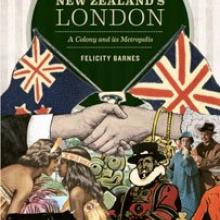
This may be the "American Century", but the old seat of empire remains young Kiwis' favourite northern hemisphere destination.
We've had a very long love affair with the British capital, as Felicity Barnes explains in this important new book. Glance through the National Library's Papers Past website and you will see how often fashionable clothing, books, luxury goods and touring shows made the most of their London origins. More recently, think Carnaby St or Savile Row.
For anyone in New Zealand shipping, Leadenhall St, London, was the centre of the commercial world.
Forty years ago, publishers A.H. & A.W. Reed appointed an agent there to open its post office box simply for the prestige of including London with its Australian and New Zealand branches on its books' imprint pages!
It has been a two-way process, with New Zealand acting as London's farm (with Timaru's Smithfield Freezing Works sending Canterbury lamb for sale at Smithfields in London) while New Zealanders have made forays there, exploring the heritage landscapes of a culture they made their own.
Barnes introduces the useful concept of city and its hinterland to explore the curious relationship between London and New Zealand.
It works far better than the old strict empire/colony divide.
"Empire remains important, but it was not the only factor in the creation of London as a "natural part" of New Zealand's culture."
Although cities and hinterlands are normally physically contiguous, steamships, culture and the media worked just as well for two archipelagos 12,000 miles (19,200km) apart.
The introduction discusses New Zealand historiography's emphasis on our distinctive nationalism.
Historians may have loved to publish with Oxford University Press, but they played down London's cultural role.
Oddly, that is now being redressed by the new histories of empire which offer more nuanced views of colonisers and the colonised.
There are nine chapters. The book follows a basic chronological structure, placing the greatest emphasis on the half-century between 1890 and 1940.
The first two chapters look at how New Zealanders used their imaginations to co-opt metropolitan space, mentally making ourselves co-owners. We built New Zealand House and made ourselves at home in the city during the two world wars.
Chapters 3 and 4 look at how travellers and expatriate writers, some resistant to the old notion of Britain being "Home", not only absorbed British culture but came to see London as an extension of New Zealand's cultural landscape. Jane Mander found herself being moved as emotionally by walking around Westminster Abbey as she had been by the sight of majestic kauri trees.
Chapters 5 and 6 look at aspects of the economic exchange. "London's Imaginative Hinterland" takes a revealing look at the extraordinary campaigns for our primary products, peddling an image of antipodean farming "that was as much metropolitan fantasy as hinterland reality".
The final chapters focus on media - mass media, home movies and New Zealand on television. Fleet St shaped our thinking, along with undersea cables, radio and film. Like our novelists and historians, our newspaper editors and journalists often served a stint in London.
Only recently have television and the new media dismantled much of the relationship between city and hinterland, although some vestiges remain.
There's a lot to think about, and New Zealand's London will repay slow, careful reading.
It's a considerably reworked version of an award-winning PhD thesis.
Fortunately, it does not read like one and with a large gallery of interesting and sometimes quirky images, it should appeal to general as well as specialist readers.
• Gavin McLean is a Wellington historian.











